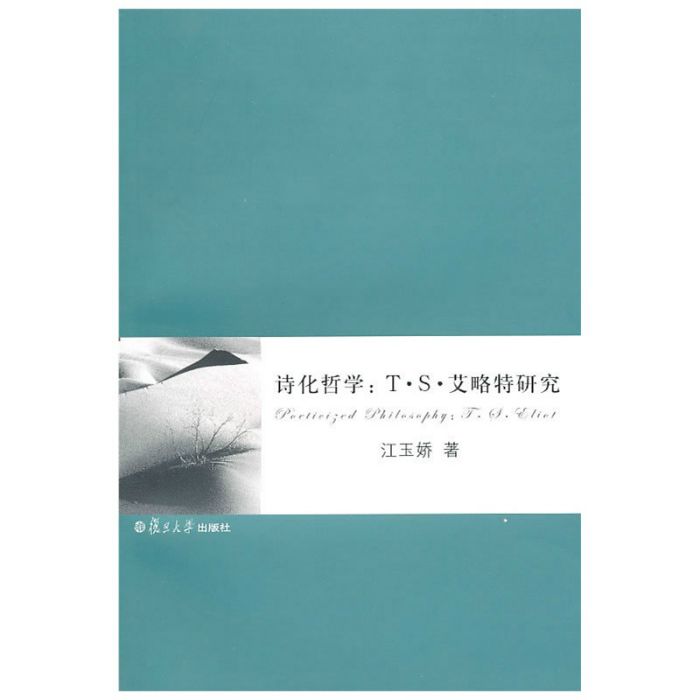《詩化哲學:T·S·艾略特研究》是由復旦大學出版社於2010年5月1日出版,作者江玉嬌。
基本介紹
- 書名:詩化哲學:T·S·艾略特研究
- 作者:江玉嬌
- ISBN:7309072596, 9787309072594
- 頁數:356頁
- 出版社:復旦大學出版社
- 出版時間:2010年5月1日
- 裝幀:平裝
- 開本:32
內容簡介,圖書目錄,
內容簡介
《詩化哲學:T·S·艾略特研究》主要探討艾略特(1888-1965)的“秩序理論”,如何從哲學領域轉化、運用、實踐到其詩學、宗教、文化、社會與創作之中,構成一個密不可分的整體。“秩序理論”是T·s·艾略特眾多理論中的一個極其複雜、極其矛盾的核心學說之一,它是理解艾略特的哲學思想、宗教思想、詩學理論和創作活動的重要線索。對各種“秩序”的探討貫穿了這位“詩人哲學家”的一生:從孩提時候的“神秘幻覺”;“結束小姐與開始先生結婚”;“上先生與下小姐私奔”(Ackroyd22),到年老時的“上升的路就是下降的路,向前的路就是向後的路”;“開始就是結束,結束就是開始”(CP“Four Quartets”189,210,221)。但一系列有關秩序理論的正式出現是在艾略特的博士論文《認知與經驗:布萊德利的哲學研究》(1911-1916年完成,1964年出版)中,後來完善於他的詩學和戲劇理論中,並在他的創作中得以印證和實踐。艾略特的秩序理論既是一種形而上的哲學與宗教的探討,也是一個詩學和創作的具體實踐過程。艾略特一生在“思”與“詩”之間的不斷求索中艱難地摸索著,從哲學秩序到詩學秩序,從宗教秩序到倫理道德秩序,從文化秩序到社會秩序,從世俗秩序到非世俗秩序,最終找到了一個包羅萬象的“宇宙秩序”。
圖書目錄
Acknowledgements
Abstract(Chinese)
Chapter One Introduction
1.The Importance of the Practicing of Theories
2.Eliot's Social Position as a Philosopher
3.Eliot's Philosophical Research Projects
4.The Necessity of the Research in Eliot's Theory of Order
5.A Brief Introduction to this Study
Chapter Two Eliot's Order from the Philosophical Perspective
1.Epistemological Point of View
1.1 A Dialogue Between Objectivity and Subjectivity
1.1.1 Feeling Connecting Subjectivity with Objectivity
1.1.2 Impression's Connecting Subjectivity with Objectivity
1.1.3 The Finite Center Connecting Subjectivity with Objectivity
1.2 A Dialogue Between“Inner”and“Outer
1.3 A Dialogue Between Reality and Ideality
1.4 A Dialogue Between Past and Future
2.Methodological Point of View
2.1 A Dialogue Between Impersonality and Personality
2.1.1 A Dialogue Between Eliot and Personality
2.1.2 Mind Connecting Personality with Impersonality
2.1.3 Collective-Historical Unconscious Connecting Personality with Impersonality
2.1.4 A Dialogue Between Eliot's Own Personal Emotions and Poetic Experience
2.2 A Dialogue Between Rationality and Irrationality
2.3 A Dialogue Between Criticism and Aesthetics
2.4 A Dialogue Between Classicism and Romanticism
Chapter Three Eliot's Order from the Poetic Perspective
1.Linguistic Point of View
1.1 A Dialogue Between Concrete Words and Abstract Ideas
1.2 A Dialogue Between Words and Meanings
2.Psychological Point of View
2.1 A Dialogue Between Words and Objects
2.2 A Dialogue Between Objects and Sensation
2.3 A Dialogue Between Sensibility and Intelligence
Chapter Four Eliot's Order from the Cultural Perspective
1.Religi OUS Point of View
1.1 A Dialogue Between Mysticism and Scepticism
1.2 A Dialogue Between Philosophy and Religion
1.3 A Dialogue Between God and Man
1.4 A Dialogue Between Man and Nature
1.5 A Dialogue Between Religious Pluralism and Salvation
1.6 A Dialogue Between Fire and Soul
1.7 A Dialogue Between Birth and Death
2.Ethical Point of View
2.1 A Dialogue Between Poetry and Wisdom
2.2 A Dialogue Between Philosophy and Wisdom
2.3 A Dialogue Between Religion and Wisdom
3.CulturalPointOfView
3.1 A Dialogue Between Tradition and Time
3.2 A Dialogue Between Tradition and Language
3.3 A Dialogue Between Objectivity and Tradition
3.4 A Dialogue Between Literature and Tradition
3.5 A Dialogue Between Religion and Culture
3.6 A Dialogue Between Culture and Tradition
Chapter Five Eliot's Order from the Sociological Perspective
1.A Dialogue Between Individual and Community
2.A Dialogue Between Self and the Universe
3.A Dialogue Between Religion and Society
4.A Dialogue Between Culture and Society
5.A Dialogue Between Primitive Rituals and Modem Society
Chapter Six Conclusion
1.A Dialogue Between the Rose-Garden and the Garden of Eden
2.A Dialogue Between Eliot and Order Works Cited
1.T .S. Eliot's W0rks Cited
2.Eliot's Papers Cited
3.The Other Writers Works Cited
Index

